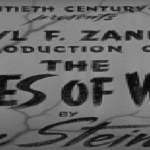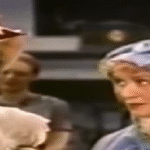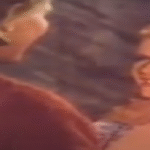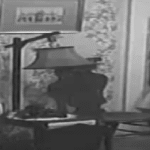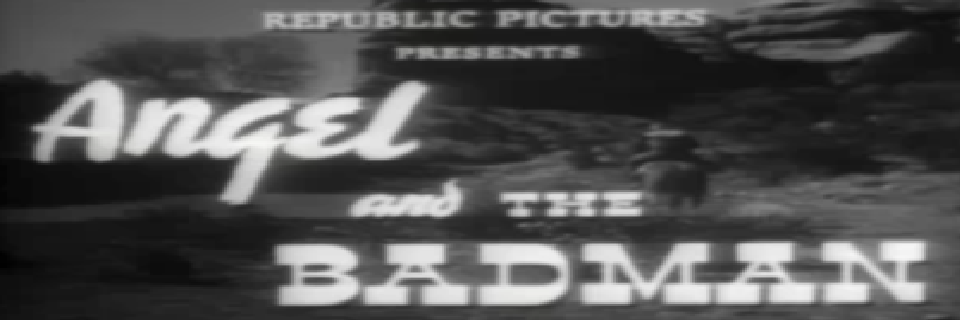Angel and the Badman is a 1947 American Western romance film written and directed by James Edward Grant. Starring John Wayne and Gail Russell, it is a thoughtful and character-driven tale that subverts many of the traditional elements of the Western genre. Rather than relying solely on gunfights and rugged individualism, the film explores themes of redemption, love and moral transformation, all set against the stark yet beautiful backdrop of the American frontier.
The film begins with Quirt Evans, a notorious gunslinger, collapsing from exhaustion and an untreated gunshot wound near a remote farmstead in the desert. He is found by Penelope Worth, a young Quaker woman, and her family, who take him in and nurse him back to health. The Worths live by a strict code of non-violence, honesty and compassion, which immediately contrasts with Quirt’s rough, lawless background. Their gentle way of life is alien to him, yet it is clear from the outset that he is touched, albeit begrudgingly, by their kindness.
Penelope, or Penny as she is affectionately called, is especially drawn to Quirt. Played by Gail Russell, Penny is sincere, principled and quietly determined. She sees in Quirt not merely a wounded man, but a soul capable of change. Though she is aware of his violent past, she believes in his potential for goodness and treats him with trust rather than suspicion. Her unwavering belief in him becomes the emotional centre of the film.
Quirt, portrayed by John Wayne with a mixture of stoicism and vulnerability, is initially wary of the Worths’ hospitality. He is used to living by the gun, and their pacifist values bewilder him. However, he is not ungrateful, and as he recovers, he begins to help around the farm, learning the rhythms of a life not driven by violence. Despite his gruff exterior, a softer side begins to emerge, revealed particularly in his growing affection for Penny.
The story progresses slowly, focusing more on the internal changes taking place within Quirt than on dramatic action. This is not to say the film is without tension. News of Quirt’s whereabouts spreads, drawing the attention of both lawmen and outlaws. A local marshal, suspicious of Quirt’s motives, keeps a watchful eye on him, while Laredo Stevens, a former associate turned rival, seeks vengeance. The threat of violence hangs over the story, a constant reminder of Quirt’s past, even as he contemplates a future with Penny.
Much of the film’s charm lies in the interplay between Quirt’s worldly, often cynical outlook and the simple, sincere lifestyle of the Worth family. The dialogue is laced with humour and warmth, especially in scenes involving Penny’s parents and their quiet but firm attempts to guide Quirt towards a better path. There is no force or coercion, only a steady example of a different kind of strength – one rooted in peace rather than domination.
As Quirt becomes more involved with the family, he begins to question the values he once held. He attends a Quaker meeting, listens to the Worths’ teachings, and starts to reflect on his life choices. His transformation is subtle but significant. He still carries his gun, still reacts with instinctive caution, but the violence in him begins to ebb. Penny’s love and faith play a crucial role in this transformation, offering him not just affection but a sense of belonging he has never known.
The turning point comes when Penny confesses her love for Quirt. She does so openly and without expectation, simply stating how she feels and expressing her desire for him to stay. For Quirt, who has always lived as an outsider, this declaration strikes deeply. However, he knows that staying means giving up the life he has known, and he struggles with the decision. He leaves, ostensibly to deal with unfinished business, but it is clear he is also trying to reconcile his conflicting identities – the gunman and the man Penny believes he can be.
Inevitably, Quirt’s past catches up with him. Laredo Stevens and his gang confront him, forcing a final showdown. Yet unlike the typical Western climax, this confrontation is handled with restraint. Quirt prepares for violence, but at the last moment, he hesitates, influenced by everything he has experienced with Penny and her family. It is the local marshal who ultimately intervenes, sparing Quirt from falling back into his old ways. The violence is thwarted not by gunplay, but by choice – a powerful deviation from the genre’s norms.
In the film’s conclusion, Quirt returns to Penny, symbolically leaving his gun behind. He chooses love over vengeance, peace over violence. The final scene, in which he rides off with Penny, suggests a new beginning – not just for their relationship, but for Quirt’s soul. His redemption is not dramatic, but it is deeply earned, forged through human connection and quiet transformation rather than flashy heroism.
From a production standpoint, Angel and the Badman is notable for being one of the first films produced by John Wayne himself. The role of Quirt Evans marked a departure from Wayne’s usual portrayals of stoic, action-oriented heroes, allowing him to explore a more introspective character arc. Gail Russell, though young and relatively inexperienced at the time, delivers a performance filled with sincerity and emotional depth, grounding the film in authenticity.
The cinematography captures the stark beauty of the Western landscape, contrasting the vast, open spaces with the intimate interior of the Worths’ homestead. The film’s score, composed by Richard Hageman, is understated yet effective, supporting the narrative without overwhelming it. The pacing, while slower than many contemporary Westerns, allows for a deeper exploration of character and theme.
Angel and the Badman stands out in the Western canon for its gentle, almost poetic approach to storytelling. Rather than glorifying violence, it questions its necessity. Rather than celebrating the lone gunman, it offers a vision of redemption through community and love. It is a film that suggests strength can be found in kindness, and that even the hardest of hearts can be softened by grace.
Angel and the Badman is a unique and enduring Western, one that challenges the conventions of its genre while delivering a heartfelt story of personal change. Through its rich characters, moral depth and quietly powerful message, it remains a moving testament to the idea that even those who seem beyond salvation can find a new path, if only they are shown the way.

